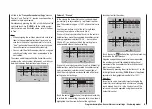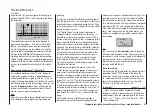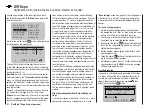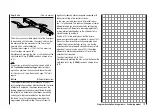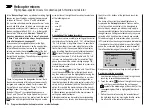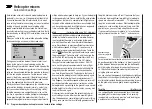
109
Program description: wing mixers – fixed-wing model
ing flaps are defined; this is intentional, as it elimi-
nates the danger of errors when a flap command is
given.
The basic programming procedure
Use the
1.
buttons of the left or right-hand touch-
key to select the desired mixer.
Use the
2.
button of the left or right-hand touch-key
to move to the right-hand column, marked by the
switch symbol
at the bottom edge of the screen.
Touch the central
3.
SET
button of the right-hand touch-
key; the corresponding input field is now highlighted
(black background).
Use the arrow buttons of the right-hand touch-key to
4.
set the desired value, and assign the switch if neces-
sary, as described on page 57.
With the exception of the “Diff. red.” line, negative and
positive parameter values are possible; this may be
necessary to obtain the correct direction of servo ro-
tation (control surface deflection).
Simultaneously pressing the
or
buttons of
the right-hand touch-key (
CLEAR
) resets an altered
value to the default value.
Touch the central
5.
SET
button of the right-hand touch-
key to conclude the input process.
Mixer neutral point
(offset)
The neutral point of the mixers …
Aileron
NN *
Elevator
NN *
Elevator
NN *
… is by default the zero point of the transmitter control,
i. e. that is the point at which they have no effect. At the
end-point of the transmitter control the full mixer value is
applied.
The default neutral point (“offset”) of the mixers …
Airbrake
NN *
… at which the airbrakes are
always retracted
, is the
forward position of the Ch 1 stick (throttle / airbrakes) if
you select “none” in the “Motor at Ch 1” line of the “
Base
settings
” menu, and is the back position of the Ch 1
stick if you select “none/inv”.
diff aile
(differential aileron travel)
Aileron differential compensates for an unwanted side-
effect which occurs when ailerons are deflected: the
problem known as “adverse yaw”. When ailerons are
deflected, the drag generated by the down-going aileron
is greater than that produced by the up-going aileron.
The differential drag causes a yawing motion around the
vertical axis in the opposite direction to the desired turn.
This effect is much more pronounced in model gliders
with high aspect ratio wings than in power models with
their much shorter moment arms, and usually has to be
countered by giving a simultaneous rudder deflection in
the opposite direction to the yaw. However, this in turns
causes additional drag and reduces the aircraft’s ef-
ficiency even further.
Aileron differential reduces the angular travel of the
down-going aileron relative to the up-going aileron, and
this reduces the drag and therefore the adverse yaw.
However, electronic differential can only be applied
if each aileron is actuated by its own servo, usually
mounted in the wings themselves. The shorter pushrods
also result in virtually slop-free aileron linkages with
reliable centring.
Mechanical solutions are also possible, but they usually
Notes:
There are various alternative methods of positioning
•
the camber-changing flaps; these include:
a) settling on just one position per flight phase, sim-
ply by setting appropriate trim values in the “
Pha-
se trim
” menu, as described on the preceding
double-page;
b) controlling the flaps manually using any transmit-
ter control assigned to “Input 6” (in the “T
ransmit-
ter control settings
setting the basic flap positions in the “
Phase trim
”
menu, as described earlier. Ideally the transmit-
ter control would be one of the rotary proportional
controls CTRL 6 … 8.
The selected transmitter control directly operates
the two flap servos connected to receiver outputs
6 and 7, assuming that you have specified flaps in
the “Ail. / Flap” line of the “
Base settings
” menu.
The same control determines the flap setting of
the ailerons via the percentage value entered in
the “FL
AIL” mixer line.
However, for finer control of the flap positions, we
recommend that you reduce their travel to about
25% in the “E6” line of the “
Transmitter control
settings
” menu.
c) It is also possible to leave the default setting of
“0%” in the appropriate line of the “FL
AIL”
menu, and to assign the same transmitter con-
trol to both input 6 and input 5 in the “
Transmitter
control settings
” menu. The magnitude of the ef-
fect on the two pairs of wing flaps can then be ad-
justed using the servo travel adjustment facility.
If a transmitter control is assigned to input “7”, it will
•
be de-coupled by the software if two camber-chang-
* NN = Nomen Nominandum (name to be stated)
Summary of Contents for mx-12 Hott
Page 1: ...Programming Manual 33116 mx 16 HoTT 3 en mx 16...
Page 35: ...35 For your notes...
Page 49: ...49 For your notes...
Page 55: ...55 For your notes...
Page 59: ...59 For your notes...
Page 63: ...63 For your notes...
Page 69: ...69 For your notes...
Page 91: ...91 For your notes...
Page 101: ...101 For your notes...
Page 123: ...123 For your notes...
Page 181: ...181 For your notes...
Page 193: ...193 For your notes...

